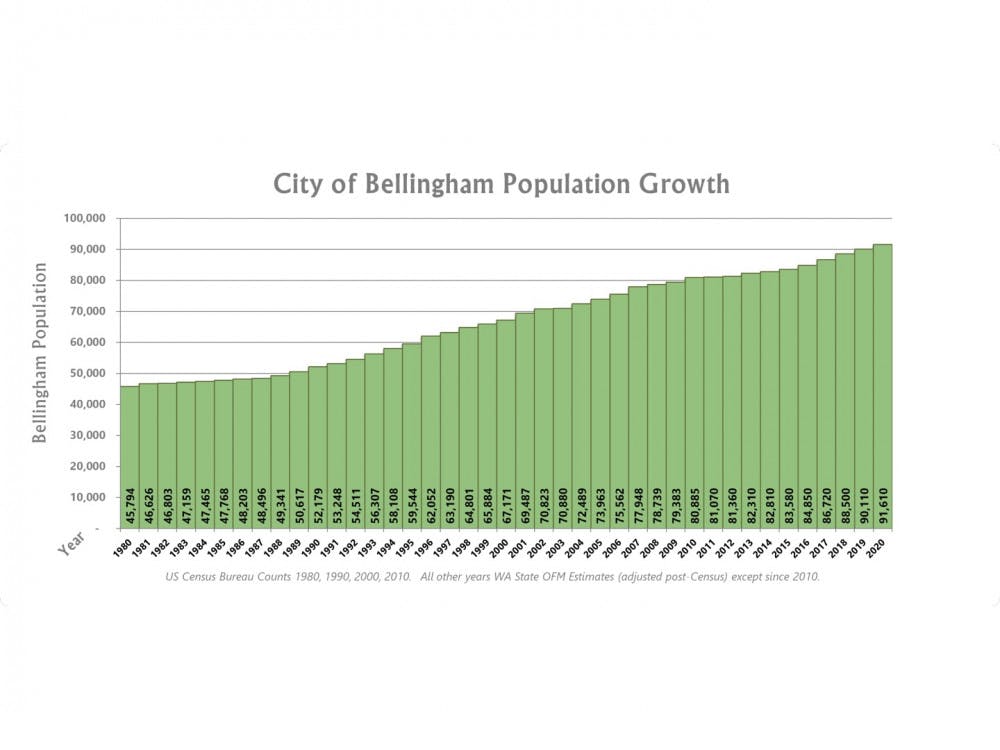
Bellingham’s population, like most West Coast towns, is growing exponentially and has been since the mid-1980s. Bellingham currently holds just above 92,000 people, according to the U.S. Census Bureau.
With such a growth rate, some residents have raised concerns. Rachel Phair, a resident born and raised in the area, said she feels like the roads were not built for the number of people here now.
“The on and off-ramps on the freeways were not thought out for this increase of people,” Phair said.
In addition to infrastructure concerns, Phair’s main concern is housing.
“Bellingham and Ferndale have built where you never would have thought there would be apartments or houses,” Phair said. “It’s sad to see some spots invaded by all the new homes and apartments.”
In 2016, Bellingham was ranked one of the 50 worst American cities to live in due to the high cost of living. Kena Brashear, a designated and managing broker in Bellingham, said she sees this in her daily work.
“It’s difficult right now because there’s not a lot of inventory,” Brashear said.
While Brashear said the housing market is strong, there is a lot of stress for her and her fellow realtors. She said they are currently seeing houses sell from between $10,000 and $200,000 over the asking price.
Chris Behee, a city geographic information system analyst for the City of Bellingham, sees this issue in his work.
“Bellingham is such a nice place to live that we have a lot of people wanting to move here consistently, so our housing market is very tight,” Behee said. “For a single-family detached house, it’s hard to find anything for less than $400,000.”
This high price point could be why, as of 2015, more than half of the housing units in Bellingham are rental units.
According to Behee, Bellingham has slowly and steadily grown since its founding in 1904, only to grow exponentially around the 1980s.
Jeanne Marie Storm, a resident who moved from the East Coast in November with her husband, said she noticed the tightness of the housing market.
“It was very competitive,” Storm said. “Once we zeroed in [on] Bellingham we saw how quickly things were selling.”
Storm said one of the main reasons her and her husband were drawn to Bellingham was the large number of outdoor activities available.
“We like to hike, ski, kayak and canoe — we even like to scuba dive,” Storm said. “Bellingham has all those things.”
Population growth is not uncommon for the West Coast, which, along with the southern regions of the U.S., has seen rapid growth in the last decade.
Erica Gardner, a senior forecast analyst for Washington state, said the economy always plays a large role in population growth.
“Migration typically follows a cyclical pattern related to periods of economic expansion and contraction,” Gardner said.
While it’s difficult to understand exactly how COVID-19 will impact the population in certain areas, Gardner said she has seen one pattern arise.
“With the pandemic, there is information to suggest that people are moving out of Seattle, to get more space rather than being in the middle of the city,” Gardner said.
This coincides with recent census data that shows a significant amount of people move to Bellingham from within Washington state rather than abroad.
Behee and the city of Bellingham predict the population of Bellingham will grow to 120,000 by 2036.
Caroline Brooks is a journalism student and a reporter for The Front. Her work includes local features and Bellingham-based news.





